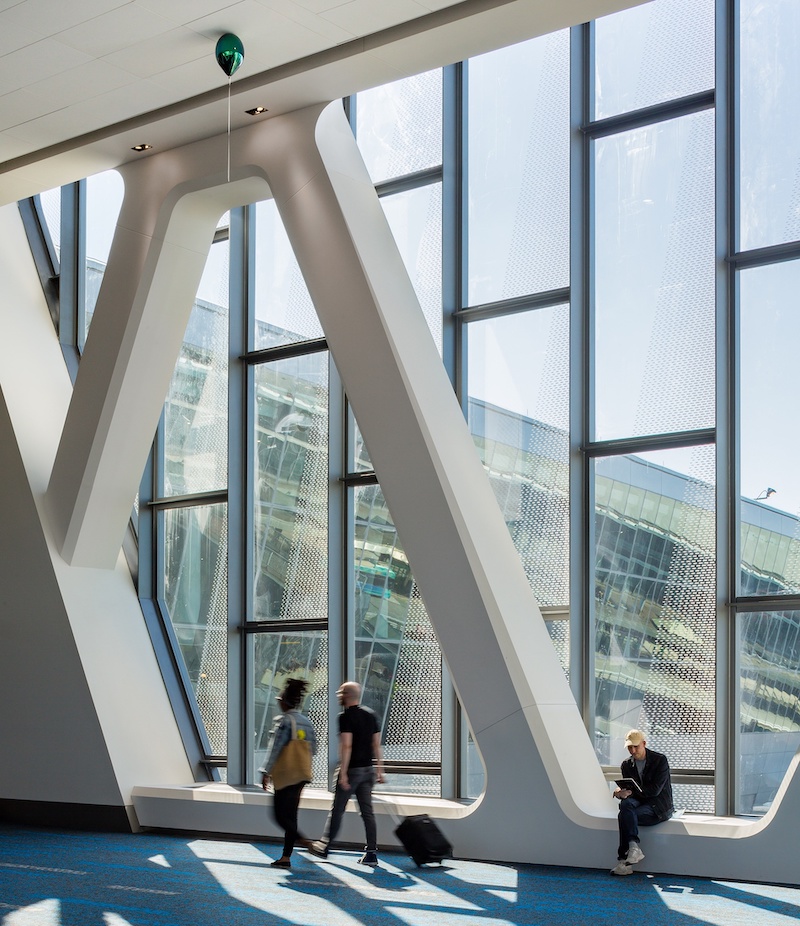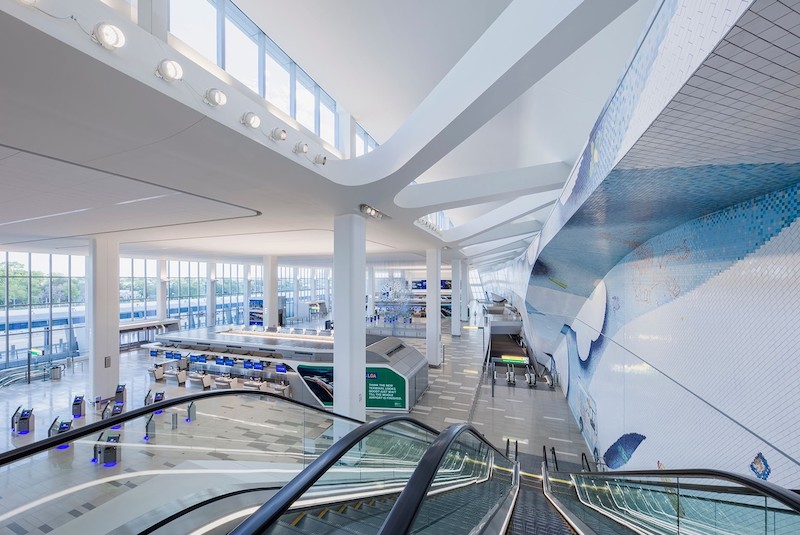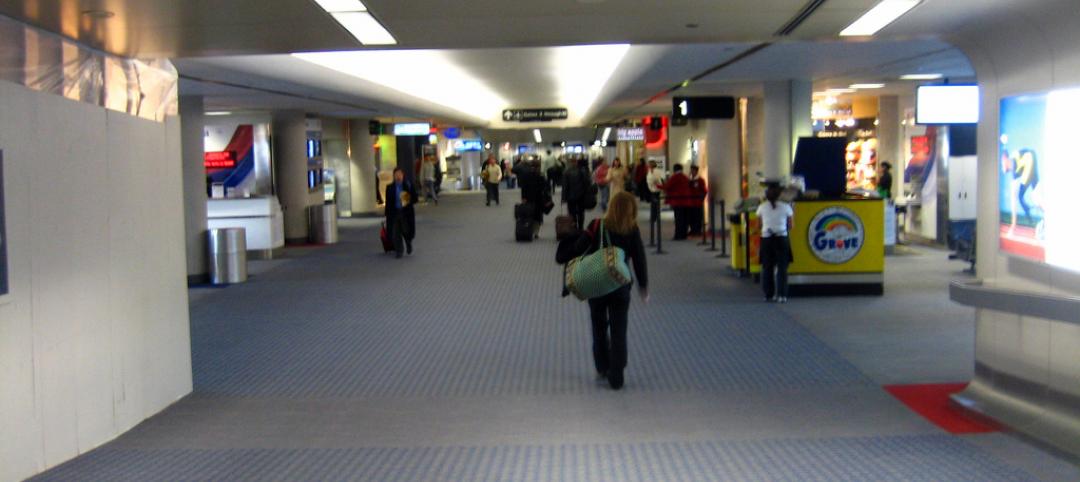LaGuardia Airport’s new Terminal B, a four-story, 850,000-sf facility that houses passenger services and amenities, has officially opened.
The steel-framed facility replaces a disjointed patchwork of structures with one that closely follows the curves of the Grand Central Parkway and the airport access roads. It was designed as a highly efficient and adaptable terminal that pays homage to the “architectural grandeur and individuality” of New York City.
“Our design concept focuses on two main components: a superior passenger experience and an exterior architectural expression that conveys a civic presence from the Grand Central Parkway,” said Carl Galioto, FAIA, HOK’s President and New York Office Managing Principal. “The building is a metaphor for New York, a city of islands and bridges, and the terminal is connected to the city with views of the skyline from the passenger bridges. Our ambition was to help transform LaGuardia into an airport with a distinct civic identity worthy of this metropolis.”

Also known as a headhouse, Terminal B includes extensive food and beverage and retail options. Connected to two island concourses by a pair of 450-foot-long steel truss pedestrian bridges, the headhouse serves as the nexus to the new Terminal B. Arriving and departing passengers can view panoramic skyline and airfield views from the transparent-walled, 65-foot-high bridges as taxiing planes pass underneath them. The bridges also enabled the design team to move the terminal 600 feet closer to the Grand Central Parkway, which allowed for two additional miles of aircraft taxi lanes that will reduce airport ground delays.
The team designed a simplified circulation network comprising over eight miles of new roadway and 20 new bridges that provide an easy connection from the airport to the Grand Central Parkway and New York City. The roadways in front of the head house frame the Grand Central Parkway, and its column structures align with the head house design to create a cohesive appearance.

Inside the terminal, all check-in and passenger screening areas are located on the third floor. This location gives Terminal B the adaptability to accommodate evolving security screening and technology as needs change. The “common-use” design allows airlines to move easily within the terminal, expanding or shrinking their footprints as needed.
See Also: A 780-ft-long pedestrian walkway is positioned over an active taxi lane at Sea-Tac International
Terminal B forgoes the widespread practice among airports of offering monumental spaces to departures while relegating low-ceilinged, basement-like zones to arrivals; incoming and outgoing passengers to Terminal B share soaring, grand-scaled sequences.

Sustainability features include non-glare daylighting, passive shading, natural local materials, and storm resiliency and the new infrastructure layout will reduce the airport’s overall carbon footprint due to lower fuel demands from taxiing aircraft. The project is targeting LEED Silver certification.
LaGuardia Gateway Partners is composed of Vantage Airport Group, Skanska, Meridiam and JLC Infrastructure for development and equity investment. Vantage Airport Group leads the redevelopment program and management of Terminal B, with Skanska Walsh as the design-build joint venture and HOK and WSP for design.

Related Stories
| Dec 8, 2014
Moshe Safdie wants to reinvent airports with Jewel Changi Airport addition
A new addition to Singapore's Changi Airport, designed by Moshe Safdie, will feature a waterfall and extensive indoor gardens.
| Nov 19, 2014
The evolution of airport design and construction [infographic]
Safety, consumer demand, and the new economics of flight are three of the major factors shaping how airlines and airport officials are approaching the need for upgrades and renovations, writes Skanska USA's MacAdam Glinn.
| Nov 18, 2014
Grimshaw releases newest designs for world’s largest airport
The airport is expected to serve 90 million passengers a year on the opening of the first phase, and more than 150 million annually after project completion in 2018.
| Nov 14, 2014
JetBlue opens Gensler-designed International Concourse at JFK
The 175,000-sf extension includes the conversion of three existing gates to international swing gates, and the addition of three new international swing gates.
Sponsored | | Nov 12, 2014
Eye-popping façade highlights renovation, addition at Chaffin Junior High School
The new distinctive main entrance accentuates the public face of the school with an aluminum tube “baguette” system.
| Oct 26, 2014
New York initiates design competition for upgrading LaGuardia, Kennedy airports
New York Gov. Andrew Cuomo said that the state would open design competitions to fix and upgrade New York City’s aging airports. But financing construction is still unsettled.
| Oct 16, 2014
Perkins+Will white paper examines alternatives to flame retardant building materials
The white paper includes a list of 193 flame retardants, including 29 discovered in building and household products, 50 found in the indoor environment, and 33 in human blood, milk, and tissues.
| Oct 12, 2014
AIA 2030 commitment: Five years on, are we any closer to net-zero?
This year marks the fifth anniversary of the American Institute of Architects’ effort to have architecture firms voluntarily pledge net-zero energy design for all their buildings by 2030.
| Sep 24, 2014
Architecture billings see continued strength, led by institutional sector
On the heels of recording its strongest pace of growth since 2007, there continues to be an increasing level of demand for design services signaled in the latest Architecture Billings Index.
| Sep 22, 2014
4 keys to effective post-occupancy evaluations
Perkins+Will's Janice Barnes covers the four steps that designers should take to create POEs that provide design direction and measure design effectiveness.
















